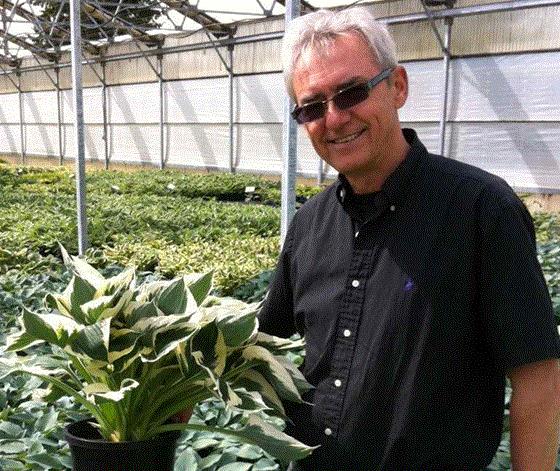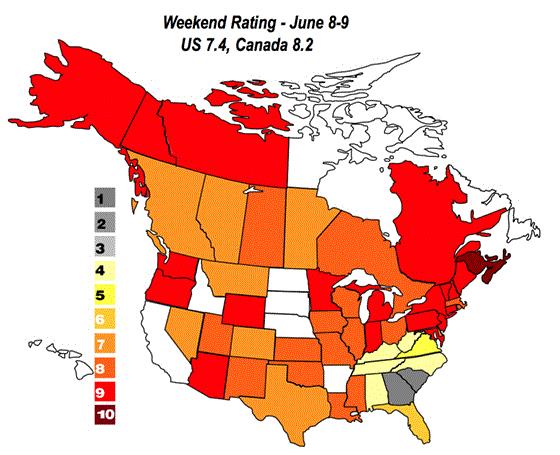Schroeders sell Valleybrook Gardens
They sold their Ontario production facility two years ago. Now they’re exiting the perennial business for good: John and Kelly Schroeder have announced the sale of the original location of Valleybrook Gardens, which they founded 40 years ago in Abbotsford, BC.
The buyer? Josami Holdings, a family-owned company newly incorporated by Joe Abi-Ad, an MBA who for the past four years has been CFO of Brookdale Tree Nursery. He saw this as an opportunity to run his own company. Said Joe in the press release, “I look forward to continuing the legacy built by the Schroeder family in this well-managed business. The Valleybrook brands have always differentiated themselves from others through their exceptional quality, thus making the company a highly attractive acquisition target. We will continue to provide the highest quality plants and best service to our customers.”
Those brands of which Joe speaks include Heritage Perennials, their trademark blue pots, Jeepers Creepers, Backyard Fresh and Rock Stars. Valleybrook will continue to produce them under license from Valleybrook International Ventures, Inc., which will continue to be held by the Schroeder family.
I asked John Schroeder via email why he was finally selling it all completely. He replied that none of his four daughters or their spouses were interested in being the second generation Schroeders in the nursery business. In fact, he added, “From the very beginning, I always intended and expected to sell the business outside of the family as my succession plan.”
 You think John was smiling then ...
You think John was smiling then ...
As for the new owner and why sell now, John answered, “We found a buyer who values what we have built, and who plans to build on that foundation together with our existing staff and management. After 40 years at the helm, this was a perfect opportunity for us to move on to new adventures.”

PanAm acquires celosia breeding
Long a distributor of Celex’s varieties of celosia, both cuts and bedding, PanAmerican Seed has decided to buy their full assortment, along with the breeding programs. Celex is known for the cut-flower celosia Neo and Sunday, and annual series First Flame, Bombay, Dracula, Kosmo and Concertina. Their varieties have won two Fleuroselect Gold Medals as well as a Quality Mark.
The two companies have been partners for more than 25 years, with Celex doing the breeding and PanAm doing the seed production, distribution, sales and marketing.
“Over our many years of partnership, we have built a successful and sustainable growing business in celosia,” says Anne Leventry, President of PanAmerican Seed. “We are pleased with all the efforts Celex has put into this class and we can’t wait to build on this momentum of excellence.”
“We are assured our Celex breeding efforts and genetics are in good hands at PanAmerican Seed,” says Peter Van Den Bosch, owner of Celex, who is nearing retirement along with business partner Henk Van Der Boog. “They will continue our work to the benefit of cut flower, potted and bedding plant growers all over the world.”
The sale will be finalized Oct. 1, when the full Celex celosia breeding assortment will be integrated into PanAm’s catalog. No employees or assets are part of the purchase.

Syngenta acquires cyclamen breeding
Not to be outdone, Syngenta has added to its cyclamen offering by acquiring the full line (11 series) from Dutch breeder Varinova, run by Bart Kuiker and Marga Janus. This broadens Syngenta’s position in the global cyclamen business, both with genetics and technical expertise.
Back in late March, during Spring Trials, the two companies had announced a joint sales and marketing agreement, with Syngenta offering some of Varinova’s genetics in the U.S. and Canada. It seems they’ve gone beyond that to a full acquisition agreement.
Said Michael Kester, Syngenta’s Global Head of Flowers, in a statement: “Cyclamen is a focus crop for us in which we are determined to grow through a broader portfolio and strong technical support to our growers. Varinova brings the complementary product portfolio and breeding pipeline we were looking for.”
Said Marga and Bart in the same statement, “This step will help bring our breeding program with beautiful Cyclamen genetics to the next level. We look forward to making use of the commercial power of Syngenta. Personally, we are very happy to give Varinova and the people continuity through this acquisition. The team of Syngenta has given us the confidence that this is a good fit, with nice people, short communication lines and a family feeling.”
For its part, Varinova will continue to sell their assortment to their existing customers.

Webinar: Ellepots + HydraFiber = Young Plant Success
My next free GrowerTalks webinar will be all about the hows and whys of using HydraFiber in Ellepots for your propagation. HydraFiber, as you may know, is a wood-fiber substrate produced in North Carolina from southern yellow pine. It’s slated for Thursday, June 20, at 1 p.m. Eastern/Noon Central.

In this webinar, titled Ellepots + HydraFiber = Young Plant Success, Dr. Bill Argo will share his research on wood fiber substrates and offer basic guidelines for growing in the Ellepot system. Bill has worked for The Blackmore Company since 1986, providing technical services on nutritional problems in plug, liner and greenhouse production around North America, and has authored or co-authored more than 200 scientific and technical publications on these and other subjects. He has done extensive research in pH and nutritional management of container-grown crops.
Bill will be assisted by Daniel Norden, Senior R&D Manager and Technical Specialist Manager for Profile Products’ horticulture business, to share findings from university and grower trials where HydraFiber Advanced Substrate has been one of the substrate components. HydraFiber has been used successfully in vegetative liner production, as well as bedding plants, poinsettias, direct-stick production, shrubs and perennials.
This is the second in a multi-part series of webinars sponsored by HydraFiber, featuring independent research and trials by academics and growing experts, focused on helping growers build an efficient and effective media program.
As usual, I’ll be your host, so you know it will be fast-paced, informative and fun!
Sign up now at www.growertalks.com/webinars.
Oh, to see part one of the series, click HERE.

How was last weekend?
Based on the scores, and as is to be expected for the second weekend of June, we’re winding down in most markets except the most northward. The U.S. scored a decent 7.4 for June 8-9, while Canada remained extra strong at 8.2 (the Territories got their mojo back!).
Here’s the map:

That’s based on 111 scores from 43 states and 9 provinces and territories.
The Pacific Northwest was the strongest region of the U.S., at 8.8. Surprisingly, British Columbia, at 7.3, didn’t score quite as high. I only got three responses from there—10, 7 and 5, so it seemed to be a mixed bag. Meanwhile, Washington scored a 10 and two 8s, and Oregon was three straight 9s.
New England was our other strong region, at 8.6. Scores were all 8s, 9s and 10s.
In fact, all the regions scored 8.0 or above with the exception of the Mountains (a close 7.8) and the South (a distant 5.1). Rain ruined the weekend for much of the Southeast, and heat and the lateness of the season did the rest of the damage. In fact, if the Southern states had scored just a few points higher (North Carolina, for instance, scored a sorry 3.5), I’m sure the U.S., like Canada, would have easily broken 8 for the weekend.
Here are the regional scores:
Northwest 8.8
New England 8.6
Midwest 8.3
West 8.1
East 8.1
Plains 8.0
Mountain 7.8
South 5.1
Up in Canada, Ontario ran the gamut from 3 to 10. But 9s and 10s outweighed the poor scores, for a 7.7 average overall. Just dropping out the one 3 I received brought the score to 8.5. And if I drop the one 5 from BC’s scorecard, it jumps from 7.3 to 8.5.
The Atlantic provinces apparently had a killer weekend, with straight 10s coming from respondents. Quebec was nearly as good, at 8.8. But the central provinces of Alberta (6.8) and Manitoba (6.5) were cold and wet, at least part of the weekend, which brought down scores a tad. Saskatchewan was a fair bit better at 8.25.
Lastly, Stan tells me Yukon and the Northwest Territory came back solidly, with 9s, but comps for the season are still down.

Can you see the forest for the trees?
Here’s something to think about as you ponder how good (or bad) your week was: Are you too close to the action to give an accurate gut assessment? Maybe you’ve gotten jaded or pessimistic in your old age, like my friend Bill Swanekamp (who insists he’s a realist).
I ask, because two of you have recently emailed to say that your POS data has shown better results than your gut instincts told you you’d had.
Last week, you may recall me writing about Sig Feile of Atlantic Nursery on Long Island. Sig was going to give his weekend a 7 or 8 until staff said no, it was a great weekend. He ran the numbers for the last five years and, lo and behold, sales were up between 7% and 20% over every previous weekend!
This week, the same happened to Beth Weidner of Weeds Greenhouse & Gardens in Missouri. Beth wrote in to say that she’d started accepting credit cards mid-season via Square POS, but hadn’t had time to explore all its features, including sales reports—just too busy, like all of you.
This week, she got around to learning the ins and outs of her new system and running the numbers. She writes:
“It appears that my cash register has been quite a bit busier also, showing an 18% increase over last year in retail sales from the greenhouses, not including the increase in custom work! I ran the numbers (now that I can find them) three times and really hope my accountant doesn’t tell me I’m looking at the wrong ones! Who doesn’t call that a 10 for the season as a whole!? I literally had my nose so close to the grindstone I couldn’t see the results.”
Beth’s business is closed for the season now, and she’s out on a boat somewhere, she says, but she ended her email with a cheery, “Here’s hoping everyone got as pleasant a surprise this season! Really appreciate seeing how everyone else is managing thru your survey. Thank you for the opportunity and analysis. Numbers can really make a difference!”
(BTW, my friend Bill rated New Jersey a 9 last weekend, which I told him is equivalent to anyone else’s 11. So New Jersey must have been amazing!)

Daisies trick aphids
Dutch researchers (leave it to the Dutch) have figured out that a Chinese daisy, Tanacetum cinerarifolium, has the ability to repel aphids by producing a pheromone that triggers a flight response in the aphids. The pheromone does double duty, too: it attracts ladybugs, a natural aphid predator.
HERE is the full story from Wageningen University.
Alas, they don’t say if it’s possible to do a little genetic manipulation to do the same thing in other flowers. But if the Dutch can invent self-healing concrete, they can figure this one out.
Beacon impatiens gets U.S. utility patent
PanAmerican Seed’s newest impatiens series, Beacon, has received utility patent protection for its new impatiens series’ unique genetic resistance to Impatiens Downy Mildew (IDM). The patent covers all six colors and two mixes of the I. walleriana series. Additional patent applications are pending.
“Receiving this patent underscores confidence in this product, and we are proud to be able to bring such an important flower class back to market,” said Lisa Lacy, PanAm’s Global Product Manager.
Beacon got a regional launch this year, with full global availability in January 2020.
www.beaconimpatiens.com.
Michigan cultivar wins Chelsea
A variegated sedum has taken the top plant honors at the venerable Chelsea Flower Show in England. It’s a Sedum takesimense called Atlantis. Normally, this sedum, which is only found wild on a small island off the coast of Korea, is green. Dave MacKenzie of Hortech in Michigan found one variegated branch growing amongst his 500 plants, and he began propagating the sport.

Chelsea has been doing a “Plant of the Year” competition for only 10 years; this is the first time a variegated plant has taken the top prize. But looking at it, you can see why the judges fell for it—that’s a pretty plant! It blooms yellow in the fall, and the foliage takes on a pink blush.
Thankfully, it seems to be widely available, at least here in the U.S.; I found it listed at Walters Gardens and Plant Delights Nursery.
Read the news HERE at the Flower Power With Jill website.
Philips offers easy conversion from HPS to LED
Signify (formerly Philips) has a new GreenPower LED Toplighting Compact light which makes switching from high-pressure sodium to LED easier than ever. The compact, passively cooled LED toplighting provides a 1-to-1 replacement for HPS lighting, using your existing electrical connections and support infrastructure.
The high light output of 1,800 µmol/s and an efficacy of up to 3.0 µmol/J help growers, effectively optimizing crop growth, enhancing crop quality and cutting operational costs. Compared to a 1,000 W HPS fixture, the Signify LEDs produce the same amount of light and have a similar light distribution, while consuming 40% less power and emitting considerably less radiant heat.
The system is suited for most greenhouse crops needing light, including vegetables, flowers, and even cannabis.
The GreenPower Toplighting Compact lights are rolling out in Europe, but presumably they’ll be available in North America, as well.
Finally ...

Much to my chagrin, my appearance as a “distinguished lecturer” at Texas A&M last fall was captured on video tape. If you want to hear (and see) what I told the assembled masses (about 75 academics plus a few students who skipped class), click HERE. It’s about 56 minutes long, but I toss in numerous jokes, so it only feels like an hour to watch.
See you next time,

Chris Beytes
Editor
GrowerTalks and Green Profit
This e-mail received by 23,686 loyal readers!
Thanks to my loyal sponsors, who help me reach the 23,686 readers of Acres Online in 66 countries. Want to be one of them (a sponsor, that is)? Give Paul Black a shout and he'll hook you up.